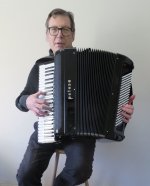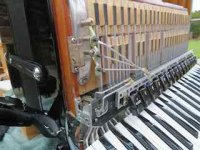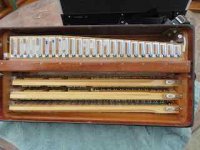The Petosa cathedral was ordered in Sept 2018 and delivered Jan 2021. There were a number of pauses to clarify the specification with the Seattle office and some quality issues with sourcing the sliders for the bass mechanism. Also I guess the work of all Italian factories was slowed during the peak of Covid restrictions. In essence the instrument could be considered a custom build and they don’t sell may like it. But excuses aside the process took 2yrs 4mths from beginning to end. Unfortunately for me Britain leaving the EU due to our popularist government’s characteristic incompetence, lead to in increase in import tariffs in January. I count myself lucky that the shipment wasn’t arbitrarily impounded by the UK Border Agency because a uniformed official believed the content of the box to be a stealth weapon!
I am an enthusiast for the quint free bass system. Having owned and played several configurations of chromatic accordions, I think the Stradella layout is an inspired invention and from a musical point of view is very logical in the context of modern Western music. There have always been limitations with the single octave range on the bass notes be it ingeniously folded back to give a sort of acceptable fudge. This is partially addressed by a well voiced quint FB which offers the best of both worlds enabling a seamless flip with between the modes, considerably extending the single note range whilst still having the triads. With a little practise this is easily effected “on the fly” because the same notes are under the fingers without the need to rethink location in a different layout, which in my hands realistically means stopping the music and restarting. During the same piece one can switch modes several times, as would apply to piano based instruments (ie chord or notes in combination or separately according to demands of the moment.)
Out of interest, my new Petosa, being a 140 bass, in
FB mode deploys 4 octaves of single notes without juggling with switching registers and the scale is very well balanced in timbre across the range. There are the usual 3 FB registers, spanning 5 octaves of bass notes. Also with this large Petosa, in
stradella mode there are two pairs of rows of bass notes pitched an octave apart on rows 1& 2 and 3&4. Rows 5 to 8 are the familiar stradella triads. I have been pleasantly surprised how useful it is to have 2 real octaves of easily accessible bass notes in
Stradella mode, without even starting to flip to
FB mode. With the 45 note RH, the realistically accessible range of this instrument is as good as any 88 note piano.
Another point harking back to a previous thread of posts on the forum about voicing, at my request the 5 voice RH has the high quint reed block rather than a detuned musette. It adds a very subtle quality to the chorus and it not at all dominant or jarring as may have been previously mentioned. Rather the sound in combination emphasises some naturally occurring harmonics giving it a baroque feel. Definitely not out of tune, a criticism sometimes heard in relation to musettes in classical music. Although narrowly tuned musettes are supposed to simulate a similar effect to vibrato for string players, in most instruments the tuning is too uneven across the range to be convincing (in my humble opinion).










